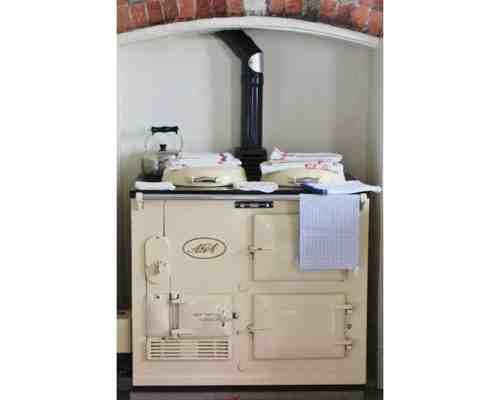Think of a classic British kitchen and an Aga range cooker is likely part of that picture. The cast-iron construction, with its shiny enamel surface and Dig-for-Victory utilitarian appeal, is a sign of an efficient and well-run home, not to mention a cozy one. Before the Aga, cooking on a range, with open flame and red-hot surfaces, was unpredictable, dirty, and somewhat dangerous. In 1922 Nobel prize-winning Swedish physicist Gustaf Dalén decided to improve his wife’s quality of life by inventing a stove that would depend on a single burner to supply radiant heat to different temperature-controlled ovens within. This meant that the potatoes could be kept warm in one oven, while the Sunday roast was finished in another. The resulting range has two hot plates (instead of burners), one for simmering and one for boiling, and these are covered with an insulated chrome lid that prevents the heat from escaping when not in use.

The Aga was brought to Britain in 1929. During World War II, the exterior was updated by industrial designer Douglas William Scott, who several years later designed that other beloved comfort giver, the British double-decker bus. The competing Rayburn range, which offers a central heating option, came along just after the war, and the cast-iron Everhot was introduced in 1995. Despite a multitude of 21st-century stove options, the traditional range cooker has never diminished in popularity. Here are some notable examples.
Above: The classic: An Aga from 1942 reconditioned by UK appliance specialist Twyford Cookers. The Aga has begun to gain popularity in the US; see below for sourcing. Here’s a primer on how Agas operate. Photograph courtesy of The Foodie Bugle.
Five to Buy
Above: The Esse Ironheart, introduced in 2004 to celebrate Esse’s 150th birthday, takes its inspiration from the earliest Esse range cookers, which were wood burning. The glass-fronted firebox provides heat as well as visual interest, but the stove makes the most of modern technology with its oven temperature control and domed hotplate covers. Go to Esse US for North American stockists. To explore this kitchen, see A Kitchen for the People, Courtesy of Prince Charles. Photograph courtesy of British Standard Cupboards.
Above: The classic Aga Four-Oven Cooker offers, in addition to four ovens, two hot plates and a warming plate. It’s available for $21,000 through authorized Aga dealers, including March, in San Francisco. See Design Sleuth: Classic Aga Cookers for more.
Above: The Everhot 150i features three independently controllable ovens, two cast-iron plates, and a three-zone induction hub. Go to Cast-Iron Range Cookers for sourcing in the UK.
Above: A Rayburn Cooker 300K in a kitchen in Galway, Ireland, designed by Guard Tillman Pollack. In the World War II make-do-and-mend spirit, the Rayburn is made of 70 percent recycled materials, which includes lamp posts, drain covers, and old cast-iron cookers. See Rayburn for UK stockists.
Above: The compact AGA Companion is just 24 inches wide and has four sealed burners, a slow-cook oven, and a roasting oven; $8,999 at A. J. Madison.
Object Lessons columnist Megan Wilson is the owner of Ancient Industries and curator of the Remodelista 100, a collection of essential everyday objects presented in the Remodelista book. Watch for her column every Tuesday, and have a look at her past lessons, including two English kitchen favorites, the Pastel Enamel Cooking Pot and the Ercol Stacking Chair.
Finally, get more ideas on how to evaluate and choose your kitchen range or oven in our Remodeling 101 Guide: Kitchen Ranges & Ovens.












